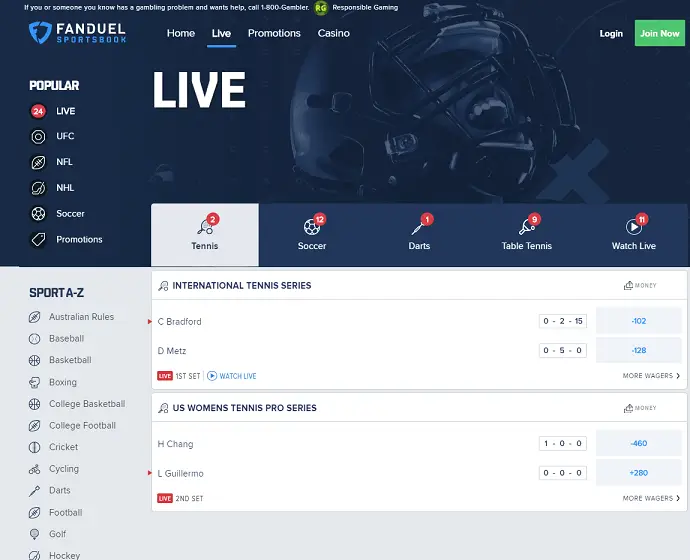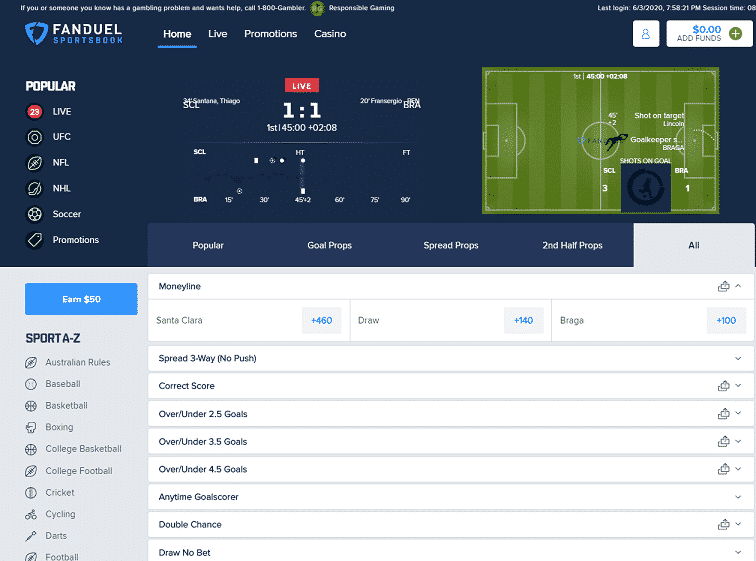Legal “live” in-play sports betting (live wagering) has become a rich facet of sports betting culture in the United States.
Recently, the popularity of live in-game sports bets has catapulted into the stratosphere, largely due to advances in mobile technology. In select international markets, in-play sports betting accounts for as much as 80% of sports betting revenue.
Live betting in the legal U.S. sports betting market hasn’t quite caught on as it has in Europe, but with the rapid proliferation of online sportsbooks in the United States, we expect the divide to be bridged soon.
Live In-Play Betting Sites
 Bet $5 Get $150 If It WinsFanDuel Promo Code: Not Needed
Gambling Problem? Call 1-800-GAMBLER or visit RG-Help.com. Call 1-888-789-7777 or visit ccpg.org/chat (CT). Hope is here. GamblingHelpLineMA.org or call (800) 327-5050 for 24/7 support (MA). Visit www.mdgamblinghelp.org (MD). Call 1-877-8HOPE-NY or text HOPENY (467369) (NY). 21+ (18+ D.C.) and present in select states (for KS, in affiliation with KS Star Casino). First online real money wager only. $5 first deposit required. Bonus issued as nonwithdrawable bonus bets which expire 7 days after receipt. Restrictions apply. See terms at sportsbook.fanduel.com.
Bet $5 Get $150 If It WinsFanDuel Promo Code: Not Needed
Gambling Problem? Call 1-800-GAMBLER or visit RG-Help.com. Call 1-888-789-7777 or visit ccpg.org/chat (CT). Hope is here. GamblingHelpLineMA.org or call (800) 327-5050 for 24/7 support (MA). Visit www.mdgamblinghelp.org (MD). Call 1-877-8HOPE-NY or text HOPENY (467369) (NY). 21+ (18+ D.C.) and present in select states (for KS, in affiliation with KS Star Casino). First online real money wager only. $5 first deposit required. Bonus issued as nonwithdrawable bonus bets which expire 7 days after receipt. Restrictions apply. See terms at sportsbook.fanduel.com.
 Up to $1000 in Bonus BetsFanatics Sportsbook Promo Code: Not Needed
Must be 21+. GAMBLING PROBLEM? Call 1-800-GAMBLER
(CO/DC/IL/KS/KY/LA/MD/OH/MI/NC/NJ/PA/TN/VA/VT/WV/WY), (800)-327-5050 or http://gamblinghelplinema.org (MA), Call (877-8-HOPENY) or text HOPENY (467369) (NY), 1-800-NEXT-STEP or text NEXTSTEP to 53342 (AZ), (888) 789-7777 or http://ccpg.org (CT), or 1-800-BETS-OFF (IA), or 1-800-9-WITH-IT (IN), or www.mdgamblinghelp.org (MD), or morethanagame.nc.gov (NC), or 1800gambler.net (WV). $1,000 No Sweat Bets offer for customers in AZ, CO, CT, DC, IA, IL, IN, KS, KY, LA, MA, MD, MI, NC, NJ, OH, PA, TN, VT, VA, WV, or WY only. Must apply this promotion in your bet slip and place a $1+ cash wager with odds of -500 or longer each day for 10 straight days. Your 10 days begin the day you establish your account. Wager must settle as a loss to qualify for Bonus Bets. Bonus Bets will equal the amount of the losing wager(s) (up to $100 in Bonus Bets per day) and expire 7 days from issuance. This offer is not available in IL, NY, & NC. Terms apply- see Fanatics Sportsbook app.
Up to $1000 in Bonus BetsFanatics Sportsbook Promo Code: Not Needed
Must be 21+. GAMBLING PROBLEM? Call 1-800-GAMBLER
(CO/DC/IL/KS/KY/LA/MD/OH/MI/NC/NJ/PA/TN/VA/VT/WV/WY), (800)-327-5050 or http://gamblinghelplinema.org (MA), Call (877-8-HOPENY) or text HOPENY (467369) (NY), 1-800-NEXT-STEP or text NEXTSTEP to 53342 (AZ), (888) 789-7777 or http://ccpg.org (CT), or 1-800-BETS-OFF (IA), or 1-800-9-WITH-IT (IN), or www.mdgamblinghelp.org (MD), or morethanagame.nc.gov (NC), or 1800gambler.net (WV). $1,000 No Sweat Bets offer for customers in AZ, CO, CT, DC, IA, IL, IN, KS, KY, LA, MA, MD, MI, NC, NJ, OH, PA, TN, VT, VA, WV, or WY only. Must apply this promotion in your bet slip and place a $1+ cash wager with odds of -500 or longer each day for 10 straight days. Your 10 days begin the day you establish your account. Wager must settle as a loss to qualify for Bonus Bets. Bonus Bets will equal the amount of the losing wager(s) (up to $100 in Bonus Bets per day) and expire 7 days from issuance. This offer is not available in IL, NY, & NC. Terms apply- see Fanatics Sportsbook app.
 $1000 Bonus BetCaesars Sportsbook Promo Code: BUSA1000
Must be 21 or older and physically present in AZ, CO, IL, IN, IA, KS, KY, LA, ME, MD, MA, MI, NJ, NY, NC, OH, PA, TN, VA, WV, or WY. New users only. Must register using eligible promo code. First bet after registration must qualify. Max. Bonus Bet: $1,000. Bonus Bet expires 14 days after receipt. Void where prohibited. See Caesars.com/promos for full terms. Know When To Stop Before You Start®. Gambling Problem? CO, IL, KY, MD, MI, NJ, OH, TN, VA, WV, WY, KS (Affiliated with Kansas Crossing Casino), LA (Licensed through Horseshoe Bossier City and Harrah’s New Orleans), ME (Licensed through the Mi’kmaq Nation, Penobscot Nation, and Houlton Band of Maliseet Indians, federally recognized tribes located in the State of Maine), NC (Licensed through Tribal Casino Gaming Enterprise), PA (Affiliated with Harrah’s Philadelphia): If you or someone you know has a gambling problem, crisis counseling and referral services can be accessed by calling 1-800-GAMBLER (1-800-426-2537) or MD: visit mdgamblinghelp.org or WV: visit 1800gambler.net; AZ: Call 1-800-NEXT-STEP; IN: Call 1-800-9-WITH-IT; IA: Call 1-800-BETSOFF. ©2024, Caesars Entertainment
Gambling Problem? Call 1-800-GAMBLER
MA: CALL 1-800-327-5050 or visit gamblinghelplinema.org
NY: Call 877-8-HOPENY or text HOPENY (467369)
$1000 Bonus BetCaesars Sportsbook Promo Code: BUSA1000
Must be 21 or older and physically present in AZ, CO, IL, IN, IA, KS, KY, LA, ME, MD, MA, MI, NJ, NY, NC, OH, PA, TN, VA, WV, or WY. New users only. Must register using eligible promo code. First bet after registration must qualify. Max. Bonus Bet: $1,000. Bonus Bet expires 14 days after receipt. Void where prohibited. See Caesars.com/promos for full terms. Know When To Stop Before You Start®. Gambling Problem? CO, IL, KY, MD, MI, NJ, OH, TN, VA, WV, WY, KS (Affiliated with Kansas Crossing Casino), LA (Licensed through Horseshoe Bossier City and Harrah’s New Orleans), ME (Licensed through the Mi’kmaq Nation, Penobscot Nation, and Houlton Band of Maliseet Indians, federally recognized tribes located in the State of Maine), NC (Licensed through Tribal Casino Gaming Enterprise), PA (Affiliated with Harrah’s Philadelphia): If you or someone you know has a gambling problem, crisis counseling and referral services can be accessed by calling 1-800-GAMBLER (1-800-426-2537) or MD: visit mdgamblinghelp.org or WV: visit 1800gambler.net; AZ: Call 1-800-NEXT-STEP; IN: Call 1-800-9-WITH-IT; IA: Call 1-800-BETSOFF. ©2024, Caesars Entertainment
Gambling Problem? Call 1-800-GAMBLER
MA: CALL 1-800-327-5050 or visit gamblinghelplinema.org
NY: Call 877-8-HOPENY or text HOPENY (467369)
 $1500 In Bonus BetsBetMGM Bonus Code: BUSABONUS
Gambling problem? Call 1-800-GAMBLER (available in the US). Call 877-8-HOPENY or text HOPENY (467369) (NY). Call 1-800-327-5050 (MA). 21+ only. Please gamble responsibly. Call 1-800-NEXT-STEP (AZ), 1-800-BETS-OFF (IA), 1-800- 981-0023 (PR). First bet offer for new customers only. Subject to eligibility requirements. Bonus bets are non-withdrawable. In partnership with Kansas Crossing Casino and Hotel. See BetMGM.com for terms. US $1500 promotional offer not available in New York, Nevada, Ontario, or Puerto Rico.
$1500 In Bonus BetsBetMGM Bonus Code: BUSABONUS
Gambling problem? Call 1-800-GAMBLER (available in the US). Call 877-8-HOPENY or text HOPENY (467369) (NY). Call 1-800-327-5050 (MA). 21+ only. Please gamble responsibly. Call 1-800-NEXT-STEP (AZ), 1-800-BETS-OFF (IA), 1-800- 981-0023 (PR). First bet offer for new customers only. Subject to eligibility requirements. Bonus bets are non-withdrawable. In partnership with Kansas Crossing Casino and Hotel. See BetMGM.com for terms. US $1500 promotional offer not available in New York, Nevada, Ontario, or Puerto Rico.
 Bet $5 Get $150 Win Or LoseBet365 Bonus Code: BETUSAGAMBLING PROBLEM? CALL OR TEXT 1-800-GAMBLER (AZ, CO, IL, IN, KY, LA, NC, NJ, OH, PA, VA), 1-800-BETS OFF (IA) or 1-800-889-9789 (TN). 21+ only (18+ in KY). Must be present in AZ/CO/IA/IL/IN/KY/LA (select parishes)/NC/NJ/OH/PA/TN/VA. New Customer Offer Bet $5 and Get $150 in Bonus Bets at bet365. *Subject to meeting qualifying criteria. Minimum wager $5. Minimum odds -500 or greater. $10 minimum deposit. Paid in Bonus Bets. Bonus Bets wager excluded from returns. New customers only. Available in app only, time restrictions and T&Cs apply.
Bet $5 Get $150 Win Or LoseBet365 Bonus Code: BETUSAGAMBLING PROBLEM? CALL OR TEXT 1-800-GAMBLER (AZ, CO, IL, IN, KY, LA, NC, NJ, OH, PA, VA), 1-800-BETS OFF (IA) or 1-800-889-9789 (TN). 21+ only (18+ in KY). Must be present in AZ/CO/IA/IL/IN/KY/LA (select parishes)/NC/NJ/OH/PA/TN/VA. New Customer Offer Bet $5 and Get $150 in Bonus Bets at bet365. *Subject to meeting qualifying criteria. Minimum wager $5. Minimum odds -500 or greater. $10 minimum deposit. Paid in Bonus Bets. Bonus Bets wager excluded from returns. New customers only. Available in app only, time restrictions and T&Cs apply.21+ to Play, T&Cs Apply. Gambling Problem? Call 1-800-GAMBLER
What Is Live In-Play Betting?
Traditionally, the first crack of the bat or first dribble on the hardwood hardly signifies the end of betting.
Put simply, in-play wagering is betting on a game already in progress. Bettors will find that many of the most popular pregame bets morph into an in-play form once the bell sounds. These include point spreads, moneylines, totals, and derivatives. Players can even parlay multiple live bets together or mix and match live and pregame wagers as they see fit. The possibilities aren’t endless, but they’ll often feel that way.
In-play wagering differs subtlety from traditional in-game wagering. In-game wagers only occur when there is downtime, like a timeout or at halftime, whereas in-play odds may change after every single event. Whether it be a run on first down, a missed 3-pointer, or a save by a goalie, it will all be reflected in the in-play betting odds.
For traditional game bets such as “who will win” or totals, the odds will fluctuate based on what happens. Imagine Team ABC walked onto the field as a big favorite over Team XYZ. Just seconds into the game, two of the star players on ABC suffer injuries and have to leave the game.
Suddenly, it doesn’t look like ABC should be such a huge favorite anymore. In fact, XYZ could actually steal this game. The oddsmakers are thinking the same thing, and the real-time odds on who will win are rapidly adjusted.
For prop bets, the same thing can happen. Let’s say a star player has a prop for Over/Under 100 receiving yards for the game. The opposing team contains him well in the first half, and he doesn’t even haul in one ball. The Under on that prop may start to look like a much likelier outcome. The odds for that bet will adjust, and bettors can capitalize or stay away as they see fit.
As you may have surmised, the nature of live in-play betting dictates that the odds change constantly, and bettors often have mere seconds to place an in-play wager before the odds shift again.
In-play is largely a product of technology, with today’s computers able to run algorithms that produce up to the minute odds within seconds. Are the results as accurate as pregame lines? No, and as a result, the playing field between bookmakers and players is more level.
The Limitations Of Live Sports Betting
The main hurdle to in-play wagering is time. Whereas players have hours and often days to plot their course for a game that hasn’t yet started, they’ll be lucky to have 10-20 seconds in between plays to grab an in-play line of their liking.
Time is so impactful, that at retail sportsbooks, in-play betting is much less of a thing. Instead, in-game dominates, with bettors primarily restricted to placing their wagers during prolonged downtimes such as commercial breaks. And that’s fair, as it would be just about impossible for bettors to find a line they like while the game is flowing and get to a betting kiosk or cashier fast enough to plunk down money on it.
Therefore, most live sports betting wagers are going to be made via mobile or desktop.
Furthermore, in-play bet types are less prevalent compared to pregame. For instance, while one might find 200 different pregame wagers for an NFL game on a site like BetRivers Sportsbook, in-play wagering might be limited to 70 or 80 bets. It’s also much more common to find in-play wagers on game outcomes than on individual player outcomes, unless we’re talking about a sport like tennis where individual and game outcomes are synonymous with one another.
In-play betting markets are also more restrictive than pregame. This makes sense, as covering every single play for every single game would require a tremendous amount of computing power and human resources. But don’t worry, all major U.S. markets, like NFL, NBA, NHL, MLB, as well as soccer, tennis, and a variety of niche sports, feature in-play wagers.
Placing In-Play Wagers
So now that you have a semblance of how in-play wagering works, just how do we go about doing it?
Step #1: Ensure that your mobile sportsbook offers in-play wagering
This one is sort of a give me: If your mobile book doesn’t offer live betting, then it’s game over. Luckily, in-play wagering has become an extremely common offering at regulated online sportsbooks in the U.S.
Typically, the in-play wagering menu is featured predominantly on a site’s homepage. Just click into it, and in-progress games and matches will be listed. If you’re lucky, your sportsbook will provide tabs that subdivide in-play games by market. FanDuel Sportsbook does this:

Step #2: Start tracking the game
In-play wagering can be pretty intense and requires a lot of focus. For that reason, it’s best to track one game at a time, ideally one you are already watching.
Bettors can see a snapshot of popular bets right from the main live betting menu, but if they want to bet on something a bit more obscure, they’ll have to click into the game of their liking. There, they’ll be able to view all in-play wagers for that contests, typically broken down into categories.

Step #3: Understanding line movements
You found the game you want, and you’ve honed in on a bet that you want to track. Now it’s just a matter of waiting for a favorable line.
Most mobile sportsbooks make it obvious when there’s been a line movement. Typically, if a bet icon flashes green and/or displays an “Up” arrow, it means that the implied odds of an outcome worsened, and the price for the bettor improved. For instance, if the Miami Heat go on a 1st quarter tear against the Chicago Bulls, the moneyline on the Bulls might drop from -180 to -110. In this instance, the bet indicator on the Bulls would flash green, indicating an improved payout on the Bulls.
Of course, for each reaction, there must be a counterreaction. A red icon and/or “Down” arrow indicates that the implied odds of an outcome improved, and the price worsened. These red and green bursts of light happen in tandem, and of course players will also see the numbers change.
On FanDuel Sportsbook, it looks like this, and most online sportsbooks follow a similar theme:

Step #4: Placing a bet
The final step is placing the wager. For the most part, betting on an in-game line is the same as betting any other wager. You click on the bet, the bet slip populates, and you enter in the amount that you want to wager. Confirm the wager, and you’re done.
Well, it’s not always that simple.
With pregame wagering, your bet is almost always going to be accepted at the indicated line, in so long as you don’t try to wager more than your allotted limit. However, in-play lines change so fast, that by the time you place a wager, the line might already be gone.
In some instances, the book will offer the option to place the same monetary wager at the new line. Other times, it will outright reject the wager. This can be a point of frustration for in-play bettors.
Also worth noting, that if an in-play line is replaced by a lock icon (or something equivalent) the in-play line is temporarily unavailable. Most books will lock in-play wagering permanently on a contest that is drawing to a close.
Which States Allow Online In-Play Betting?
Licensed online sportsbooks in every state may offer in-play sports betting, with the only notable exceptions being rules in some states that limit the types of live bets sportsbooks may offer on college games. Readers can see BettingUSA’s college betting guide for an overview of any applicable rules where they live.
Retail sportsbooks also offer in-play wagering on occasion, but the offerings tend to be limited to markets like full-game results taken during halftime. As a result, online sportsbooks and mobile apps are better-suited for in-play wagering.
States shaded blue on the following map allow online sports betting and have in-play wagering as a result. Green states only allow retail sportsbooks, so in-play betting in those jurisdictions is limited. Red states have passed laws to legalize sports wagering but aren’t yet live. And lastly, every other state on the map hasn’t yet legalized sports betting.

States with Legal Sports Betting
Map Key
- Blue: States where online sports betting is legal.
- Red: States with retail sportsbooks only.
Key Advantages Of In-Play Betting
Perhaps the biggest advantage to in-play wagering is the increased inefficiency of the market.
For pregame wagers, sportsbooks have plenty of time to hammer the market into efficiency, resulting in final lines that are incredibly hard to beat.
Not so with in-play, where there is only as little as a few seconds between line movements. This nuance particularly benefits the fan who is watching a single game, as they can focus on the momentum of just that event, whereas books typically have to shift the odds for multiple games at the same time.
Hedging Live In-Play Bets
In-play wagering also empowers players to hedge their bets. While some may argue (correctly) that players lose value by hedging, it allows them to lock up wins.
An example would be if the Golden State Warriors go off at a pregame moneyline of +500 against the Los Angeles Lakers, and jump out to a 12-point lead halfway through the third, resulting in an in-play line of +200 on the Lakers. Players can now choose to bet an equal amount on the Lakers and guarantee themselves a profit. Yes, they’re limiting their own upside, and yes, they’ll be paying vigorish twice, but they’ll also be mitigating their risk – and for some, that’s worth it.
Lastly, in-game provides players with an unparalleled amount of flexibility. Couldn’t get a bet down because you were at work or in the grocery store? No problem; just plunk down a wager once you get home. With in-play there will be significantly more hours in the day in which sports contests are running.
Disadvantages Of In-Play Betting
In-play wagering isn’t for everyone. The frantic line movements may prove too overwhelming for new and recreational bettors. They’ll also be unable to fully recognize when a book overreacts or underreacts to certain in-game events. Getting good at in-play wagering requires a lot of focus and homework, and that homework will be extensive. Most won’t want to be bothered.
In-Play Bets Have A Higher Vig
Furthermore, the decreased efficiency of in-play markets is usually offset by a higher VIG. So whereas a book might offer a pregame point spread of -110 on both sides, it’s pretty common for the in-play line to jump to -115 or even -120.
In-Play Bets Information Delay
And unless you’re physically at the game, it’s likely that you’re going to be about 7-10 seconds behind the bookmaker in your feed. That’s because televised broadcasts have a fairly long delay. Sportsbooks, on the other hand, get their feed with a much shorter delay, giving them the advantage.
Then on top of that, the bookmaker makes you wait while it confirms your wager. If the line moves in your favor, it may deny the bet. Or, if the line moves against you, giving you a worse bet than you intended, the book will force you into either accepting the new line or cancelling the bet. It’s for this reason that many astute in-play bettors wait until there’s at least a short downtime to place their wagers.
It’s Easy To Get Carried Away With Live Betting
Finally, and most importantly, in-play grants players many more betting options – maybe too many. It transforms what was previously a form of discontinuous betting into one of continuous betting. Higher bet frequency, chasing losses, ill-informed wagers: These are all characteristics of problem gambling, and in-play wagering makes it that much easier to trigger these irresponsible habits. Take caution, and if you find yourself chasing or making random wagers, it may be time for a break.
Live Betting Advice For Beginners
- Avoid egregious vig: Some books charge an absurd premium on live bets. It’s your job to find the ones that don’t. We don’t recommend doing this during the game, as you’ll already have enough on your plate. Instead, take some free time to learn about your mobile sports betting options, and check out their live lines. Find the ones with the lowest vig, and only leave them open during the game.
- One game is plenty: One of the characteristics of a winning in-play bettor is that they only track a very limited number of games, often just one. Sure, there’s more to professional sports betting than just that, but if you want to minimize your losses right out of the gate, focus exclusively on one game, preferably one that features teams you already follow regularly. Remember, the books have very limited time to set live lines and must do so for multiple games – use this knowledge to your advantage.
- Don’t chase: Always set a budget for in-play betting, and if that budget evaporates, you’re done for the day. The worst thing bettors can do is chase losses on events they know little about. This applies doubly for in-game where you’ll be paying a steep vig. You wouldn’t enter a coin flipping contest where the rules stated you would win $1 on heads and lose $1.20 on tails. By the same logic, don’t place random in-game wagers just because you’re stuck.

